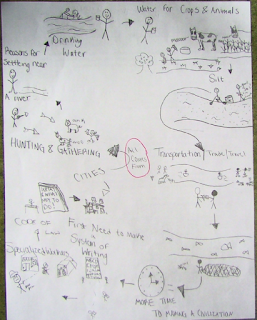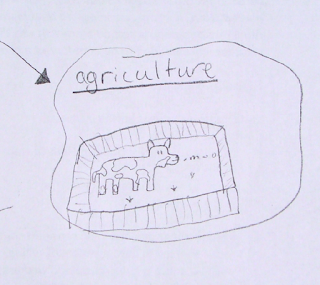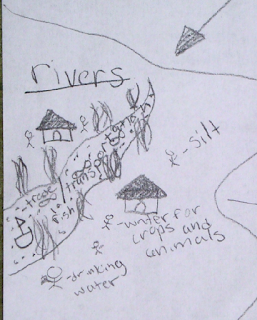This wasn't a worksheet where students had to find the answers. It was more like a puzzle: I gave the students the answers, they had to put it together in a way that made sense to them.
I liked a lot of these. And I thought it was especially interesting how students who are given the same material can come up with quite different ways of expressing and representing what was given.
Here are a couple examples:
I liked this one because it included a lot of detail, and it all made sense. I like the explanation of silt, the different cultures trading, a net for catching fish... There's a lot to like. The clock at the bottom shows me that this did not happen quickly, an idea one might get if the clock wasn't present.
The reason I'm including this one is mostly due to the bottom. It gives all the detail I need, but when it gets to code of laws, it included examples of the governments we studied earlier in the year.
PRO-TIP: If you ever get the chance to tie in previous learning on an assignment: do it. Teachers eat that stuff up. If you can show us that you not only understand the material we are currently teaching you, but that you also understood and remember the material we taught before you'll earn some extra respect and gratitude.
I liked this one because of the way they incorporated the requirements to qualify as a civilization into the city. In fact, I showed this to a couple classes before they had completely finished - and wouldn't you know it? Tons of people copied this template. The civilization has a city - look at the buildings. But the buildings are the work-places for the specialized workers, so they're pulling double-duty. BUT one building says "Join Scribes Now" which also points out the system of writing. (Scribes is a word my students should probably know or learn at some point, so I was glad he used it.) And the building on the end says "Court house" and "laws". So, those two buildings show that civilizations had cities, specialized workers, and a system of writing or code of laws.
I liked how this student progressed from hunting and gathering to agriculture, then had the river flow through the whole paper. To me, it seemed like humanity was walking got to this big river that's always been there and said, "Hey... why don't we hang out here for a while?" And then they developed a civilization there.
I like how the progress is very clearly labeled in this picture. The sections are separated and clearly defined. We can see where to start, and where we end. ...And there's a lot of detail.
It's always interesting to see the various ways students present material that is the same for all of them. You might think I'd get 160 identical flowcharts. But no, each one is unique as each student is unique.
Students may earn extra credit by reading and discussing this post with an adult. After you've read and discussed it, write a couple sentences about your discussion. Have the adult that you read it with sign the paper, hopefully proving they read and discussed it with you. Make sure your name, date, and hour are on it, then turn it in tomorrow.









No comments:
Post a Comment